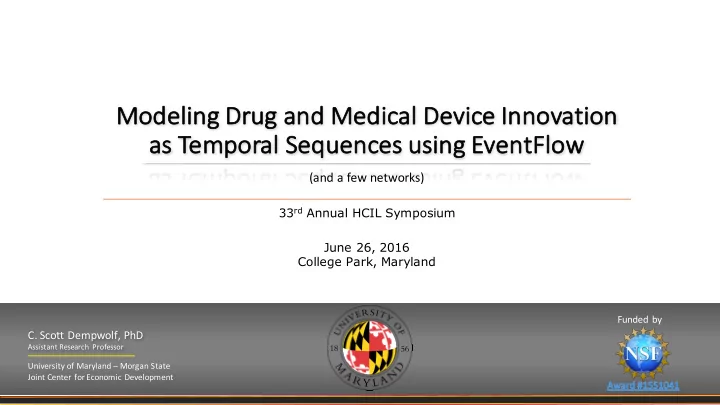

Mo Modeling Dru rug and Me Medical Device Innovation as as Temporal al Sequences usin ing EventFlo low (and a few networks) 33 rd Annual HCIL Symposium June 26, 2016 College Park, Maryland Funded by C. Scott Dempwolf, PhD Assistant Research Professor University of Maryland – Morgan State Joint Center for Economic Development
HCIL Partnership Roots 2010 2010 ME: “It’s cool, but… How do I make it useful?” BEN: “You must use NodeXL” ME: “Obiwan Shneiderman, you are my Jedi Master” 2015 2015 ME: “Obiwan, what is that disturbance in the Force?” BEN: Pennsylvania Innovation Networks 1990 – 2007 “EventFlow” Emergence of Philadelphia Biopharma cluster and Pittsburgh Nuclear Cluster Modeled with Pajek & KING
How long does innovation take? From, say, first patent application to new product in the marketplace Why does it matter? Why use EventFlow?
Innovation A process of transforming knowledge and scientific research into a new product in the marketplace. Research Invention Proof Commercialization Product Think of that process With this as a sequence of intended related activities outcome
Innovation Each activity has inputs, With this outputs, associated intended documents and artifacts outcome
Innovation Each activity involves people Contributing to and organizations producing this intended intermediate outcomes innovation outcome
Event Networks and Event Sequences The people and Activities become Intended organizations from event sequences Innovation each activity through shared people Outcome create an and organizations, event network citations, and other linkages
Aggregated event networks: Innovation Ecosystem The regenerative medicine cluster in Howard County, MD
Innovation Metrics Some are Some are Some are based on inputs based on outputs comparative indexes Product Launch None are based on Some are Some are based intended based on organizations outcome on talent & resources
Modeling Innovation Sequences with EventFlow We use newly developed EventFlow software to model innovation in drugs and medical devices from multiple datasets: RePORTER_PATENTS_C_ALL • RePORTER_CLINICAL_STUDIES_C_ALL • CTTI AACT Database • FDA Orange Book (drugs) • Drugs@FDA • Pre-Market Approvals (PMA) (med devices) • SBIR/STTR (pending) • CrunchBase (pending) • NSF (pending) • Supporting and core data sources NIH RePORTER • PatentsView • USASpending • STARMETRICS • http://hcil.umd.edu/eventflow/
A Quick Tour of EventFlow Overview (Aggregation) Individual Timelines Each product (drug or medical device) is a record in EventFlow (34,331 records) Event categories: Clinical Trials (commercialization activity) • FDA Approval (proxy for product launch) • Patents (invention) • Research •
Product-Based Innovation Metrics Temporal Metrics How long does innovation take? How many activities are involved? What types? In what sequence? How long does each take? Are there gaps? Is the sequence pattern common or rare?
How long does innovation take? (drugs) From: Patent application à FDA approval (26 products)
How long does innovation take? (drugs) From: Patent application à FDA approval (product launch) (884 drugs in the FDA Orange Book)
How long does innovation take? (med devices) From start of clinical trial è FDA approval FDA Approval after Clinical Trial FDA Approval during Clinical Trial
What’s Next? • Continued data enhancements • Work with FDA and NIH to improve data quality and matching across datasets • Add SBIR and other datasets • Descriptive statistics are important • They don’t exist now • Grouping drugs and devices by types or properties to improve confidence intervals • Sequence characteristics • How many events? What types? What order? • Gaps and overlaps • Exploration of Data • Hypothesis Testing
What’s Next? • Development of new metrics for Science, Technology and Innovation • Testing hypotheses about performance of spatial – social systems Temporal: EventFlow Social: NodeXL Spatial: GIS, MapBox
Broader applications of temporal metrics: the Illinois Battery Cluster Innovation Ecosystems Ø research component Ø Industry component Bridge Ø Bridging component Illinois Battery Cluster 2010 – 2014 Modeled with NodeXL
The Innovation Ecosystem and the Valley of Death A network representation of the valley of death Bridge Research Publication Invention Proof-of-Concept Commercialization Product
Emerging Theory & Research What’s in Bridge the Bridge? • Working Hypothesis • Regions with denser, more connected bridging components will be Measured using new characterized by faster innovation temporal metrics sequences and more innovation sequences leading to new products.
dempy@umd.edu Thank you to the US Economic Development Administration and the National Science Foundation for supporting this research
Recommend
More recommend